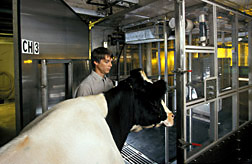More Milk With Less Feed
|
|
In pursuit of quicker track times, greater strength, or longer broad jumps, athletes typically seek dietary regimens rich in carbohydrates and other energy-boosting nutrients.
Animal scientists take a similar route when it comes to pursuing peak meat and milk production in cattle.
With the aid of indirect calorimetry, Agricultural Research Service studies help fine tune the digestibility of feedstuff's so cattle can exploit more of the energy in feeds. In dairy cows, that can also mean cutting down on the energy lost in the form of methane gas or unabsorbed nutrients in manure.
Such losses spell lost profit for the dairy producer, says dairy scientist Barbara P. Glenn.
"We want to reduce these losses so more energy is available to the cow for milk production," says Glenn, who heads ruminant nutrition studies at ARS' Nutrient Conservation and Metabolism Laboratory in Beltsville, Maryland.
Much of that research, she says, uses calorimeters to measure heat production—which reflects energy expenditures—of dairy and beef cattle. The technique is based on the animals' respiration of oxygen and carbon dioxide and production of methane, a fermentative byproduct. These act as "signposts" of the animal's energy use while breaking down the organic compounds in its feed.
Glenn says the aim of her lab's dairy research is to boost the cow's production of milk per pound of energy provided in feed. That's especially important, since the cow must first expend considerable energy for her own maintenance—to warm or cool her body, for breathing and other muscular work, and to fuel other physiological needs.
"Milk production is governed by the animal's ability to consume, absorb, and metabolize nutrients from feedstuffs," says Vic Wilkerson, an animal scientist colleague in the Beltsville lab's Energy Metabolism Unit.
"Our goal is to minimize the unused portion of a cow's feed while improving—or at least maintaining—her milk production," he says. "This means reducing waste in the forms of methane and manure."
The calorimeters are located one floor below Wilkerson's office. They comprise seven, roughly passenger-van-sized chambers of see-through plastic with stainless steel reinforcement. Three are designed to accommodate mature cows, while the other four are for young steers and heifers.
Each is temperature- and humidity-controlled and equipped with a feed manger, water bowl, and devices for collecting manure. Animal caretakers feed and milk the cows by entering an airlock in the chambers.
Though spartan by human standards, the chambers provide clean, comfortable arrangements for the animals during the 7 days calorimetry measurements are made.
"You can't just lead the cow into the chamber and measure the gas exchange," notes Wilkerson, who uses calorimetry results to predict the turnout of methane and nitrogen in manure. "You must first acclimate her by slowly increasing the amount of time she spends in the chamber."
The calorimeter allows for constant measurements of the cow's energy expenditures—from whenever she swallows a bite of feed, digests, absorbs, and converts its nutrients into milk, to the time she excretes the undigested portion in feces.
In an adjoining room, a spirometer collects gases exiting the chamber for daily analysis of carbon dioxide, oxygen, and methane levels.
Microbes, or "bugs," in the cow's rumen produce the methane as they ferment feed to help unlock its nutrients. A computer system continually records the concentration of the gases during the cow's stay in the chambers.
Established in the 1950's, ARS' Energy Metabolism Unit is one of few research facilities in the world where such studies are possible. In fact, calorimetry research begun there over 30 years ago created the Net Energy for Lactation system, called NE-L.
That system estimates the energy in a particular diet or feedstuff that is available to the cow solely for lactation. It serves as the basis for National Research Council feeding recommendations followed by dairy producers and industry feed programs worldwide.
In addition to originating the NE-L system, ARS calorimetry research has unearthed several important findings. These include:
º Methane production is best predicted by measuring the animal's intake of carbohydrate components, such as cellulose, hemicellulose, or soluble residue. By understanding a feedstuff's chemical composition, a producer can accordingly formulate rations that cut energy losses to methane.
"Between 5 and 10 percent of a cow's energy intake is lost to methane production," Glenn says. "That's not a lot on a per-cow basis. But it can mean a substantial loss of feed energy and milk production potential when expressed over an entire herd."
º Predictive equations can estimate how much manure and urinary nitrogen dairy cows produce. Such information can aid producers in managing animal wastes to control the escape of nitrogen into the environment.
"Manure management concerns relate to odor control and the runoff of nitrogen compounds in manure and urine from crop fields into groundwater," Glenn says. The equations account for the animals' nutrient intake and the production level of the dairy operation.
º The cow's gut tissues use as much as 40 percent of her maintenance energy. "It may be that we can curb what the gut needs, so more nutrients are available for milk production," Glenn notes.
In that pursuit, she and ARS colleagues Kyle McLeod and Randy Baldwin are using the calorimeters in combination with other techniques to study gut tissue metabolism.
In one such technique, a cannula, or plastic window, is surgically implanted to afford scientists a view directly into the cow's gut without endangering or disturbing her. It also allows them to remove materials for laboratory analysis, to better understand the process whereby cows turn feed into milk.
The team plans molecular studies that will shed further light on where and why the cow's rumen and intestinal tissues use so much of her dietary energy. — By Jan Suszkiw, ARS.
USDA-ARS Animal Manure and By-Products Laboratory, 10300 Baltimore Blvd., Bldg. 306, BARC-EAST Beltsville, MD 20705, Beltsville, MD 20705; phone (301) 504-9100.
"More Milk With Less Feed" was published in the September 1995 issue of Agricultural Research magazine.







